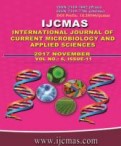


 National Academy of Agricultural Sciences (NAAS)
National Academy of Agricultural Sciences (NAAS)

|
PRINT ISSN : 2319-7692
Online ISSN : 2319-7706 Issues : 12 per year Publisher : Excellent Publishers Email : editorijcmas@gmail.com / submit@ijcmas.com Editor-in-chief: Dr.M.Prakash Index Copernicus ICV 2018: 95.39 NAAS RATING 2020: 5.38 |
Essential oils are plant-based volatile oils with strong aromatic components that are made up of different chemical compounds like alcohols, hydrocarbons, phenols, aldehydes, esters and ketones (Younis et al., 2008). Jasmine essential oil possesses sweet floral aroma and has powerful characteristics that aid the body as an anti-depressant and aphrodisiac. Three species of jasmine viz., Jasminum sambac, Jasminum auriculatum and Jasminum grandiflorum have attained commercial significance (Rimando, 2003; Green and Miller, 2009). But Jasminum multiflorum is cultivated commercially to some extent in Karnataka. The flowers of Jasminum multiflorum genotypes viz., local variety (Kakada) and a clone Acc.JM.1 was used in this experiment. In this study, Jasminum multiflorum concrete extraction was carried out by solvent extraction with hexane. The chemical composition of the concrete was analysed by gas chromatography- mass spectrometry (GC-MS). The major chemical components detected were Triacontane; Tetratriacontane; 1-Pentanol, 4-methyl-2-propyl and Nonacosane. The result of this study showed that the GC-MS study is selective, rapid and efficient for the identification of volatile components and composition variations.
 |
 |
 |
 |
 |